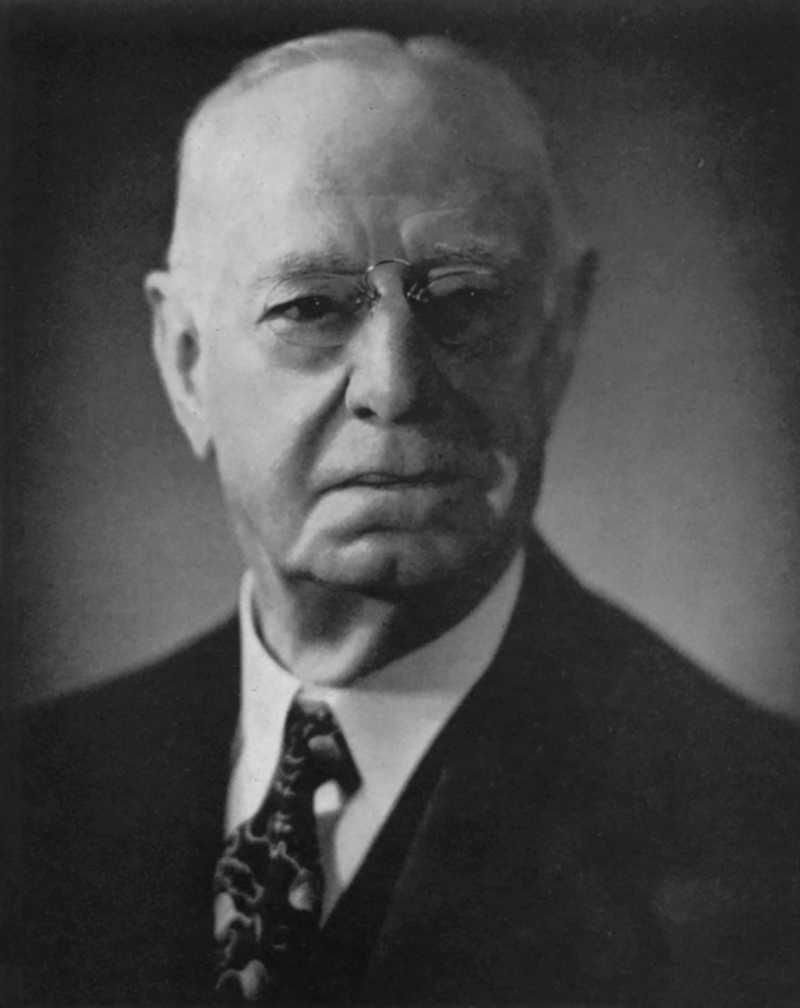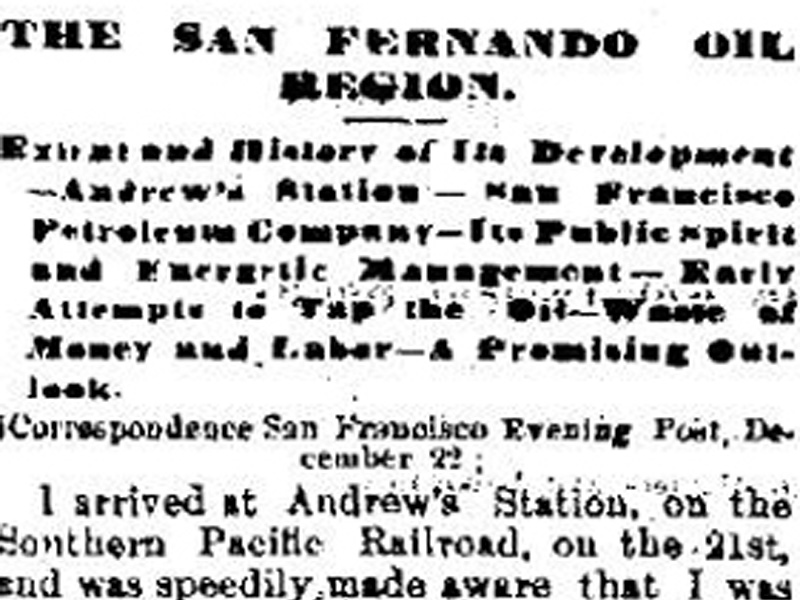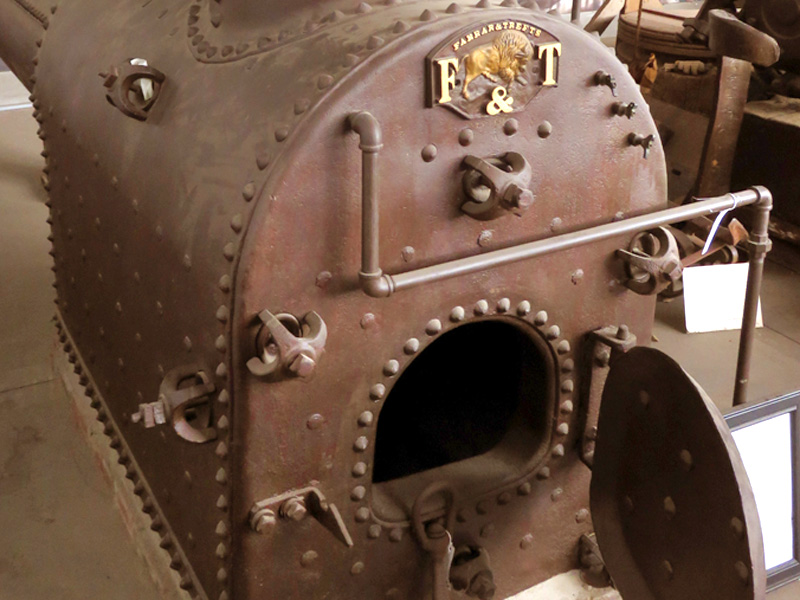|
|


Click image to enlarge
| Download archival scan
Important Mentryville-related document. California Star Oil Works stock certificate representing 1 share, issued January 14, 1901, at San Francisco to Christian Otto Geberding "C.O.G." Miller (1865-1952), founder of Pacific Lighting Corp., forerunner of the Southern California Gas Company (and rival of Edison, who didn't seem to understand that good, old-fashioned gas lighting would never be replaced by those crazy wires and sparks). 9⅞x5⅜ inches, parchment, signed by C.S.O.W. President Demetrius G. Scofied and Secretary G.B. Wheaton. Rare; possibly unique for this company. Incorporated June 16, 1876 — [records that say July 8 are incorrect] — C.S.O.W. (aka "CSO") was the company that employed Alexander Mentry, the driller who deepened the company's fourth well in Pico Canyon three months later on September 26 and produced a flow of oil the likes of which the Western United States had never seen. The California oil industry was born that day. In San Francisco, President Scofield lined up more investors and formed Pacific Coast Oil Co. (PCO) in September 1879. As manager of the company, Scofield bought up most of the other oil claims in the Pico Canyon area, some of which dated to the late 1860s (and which had been only marginally productive at best). Under Scofield's management and Mentry's superintendency, oil wells sprang up in the back of Pico Canyon, with CSO wells dotting the northern hillside and PCO wells dotting the southern. A mile and a half closer to the new town of Newhall, a little oil town was established in Mentry's name. While standard references tend to imply that California Star Oil folded into PCO at this time, in fact they remained separate entities, and Mentry kept separate ledgers for each company's workers. The history tells us that in 1900, John D. Rockefeller's Standard Oil Co. of New Jersey acquired Pacific Coast Oil and liquidated California Star Oil Works. Just why one share of stock was issued in 1901 (to someone who could afford more than one share), we don't know. We could speculate that it was some sort of legal maneuver or formality. (Maybe the company was in escrow; maybe as long as there were any outstanding shares, something could or couldn't happen. No idea.) In any event, Rockefeller's California holdings were reorganized in 1906 as Standard Oil Co. of California, with D.G. Scofield as its president.
About C.O.G. Miller By Allen L. Chickering, California Historical Society Quarterly, Vol. 31 No. 2 (June 1952), pp. 176-177.
In his eighty-seventh year, Christian Otto Gerberding Miller, usually known as C.O.G. Miller, died on April 23, 1952, in San Francisco, the place of his birth (October 1, 1865). His father, Albert Miller, banker and leading citizen of the East Bay, and his mother, Mary A. (Kendall) Miller, were both of pioneer California families. C.O.G. Miller was educated at the University of California. He began his business career in 1883 as cashier of the San Francisco branch of the United Gas Improvement Company of Philadelphia. With other members of his family, he organized the Pacific Lighting Corporation, of which he was president from 1898 to 1940, and chairman of the board from 1940 until the time of his death. This is the corporation which held control of a large portion of the gas and electric companies in and around Los Angeles, including the former Los Angeles Gas & Electric Corporation, the Southern Counties Gas Company, and the Southern California Gas Company. At his death, he was also a director and member of the executive committee of the Pacific Gas & Electric Company. Miller was deeply interested in the California Historical Society, having been one of those who participated, with Templeton Crocker, John S. Drum, H.R. Wagner, E.S. Heller and others, in its reorganization in 1922. He served as its president for several terms. Although Miller knew how to be stern and unyielding, if necessary, in business affairs, he was one of the most kindly and generous of men in San Francisco, and was noted for his constant willingness to assist in organizations devoted to the public interest, such as the Community Chest and the California Historical Society. If, at the end of the year, unforeseen expenses caused a deficit in the funds of the Society, he was always ready to assist in meeting it. Membership on the board of trustees of Stanford University enabled him, for many years, to demonstrate another side of his sympathies. If anyone had asked Miller for an opinion on the attainment of success, there can be no doubt as to the ingredient he would have emphasized and on which he, himself, had patterned his life. This can be seen from the obituaries he wrote for the California Historical Society Quarterly, upon the deaths of two of his business associates: in the September 1932 number, he called attention to Walter B. Cline's "fine sense of the duties of an executive officer, which, combined with a great love of work, made wonderful results." And, on page 184 of the June 1933 Quarterly, Miller said of George Tourny that he was "a shining example of the distance a man can go who combines capacity with honesty and a willingness to work." C.O.G. Miller was married first to Miss E. Havemeyer Tucker, who died March 28, 1896, and second to Miss Janet McAlpin Watt, to whom he was married on April 21, 1898. The latter survives him, as do three children, five grandchildren, and eight great-grandchildren.
LW3555: 9600 dpi jpeg from original stock certificate purchased 2019 by Leon Worden (Holabird Americana, Lot 1761, May 16, 2019); ex-Ken Prag American Stock Certificate Collection.
|
CSOW Time Book
1887-1889
CSOW Stock Certificate 1901
SCV History Moment
Early Oil & Gas Production in Calif. (Video 1985)
Standard Oil Co. History to 1929
Description Jan. 1877
Description May 1877
Description 9-26-1882
Oil Tank Const. & Death 1883
Mentryville 1885-1891
CSO Hill 1883
Oil Works ~1885
The Pico Field 1890
PCO Hill ~1890s
CSO Jackline Plant
Farrar & Trefts Boiler
New Boiler 1893?
Mentryville 1890s-1900s
Reamer Patent 1900
Machine Shop 1910
Machine Shop 1910s
Natural Gas-to-Gasoline 1913/14
Mentryville ~1920
Pico No. 4, 1931
CSO Jackline Plant
PCO Jackline Plant Remnants
Darryl Manzer at Firehouse ~1961
Darryl Manzer at Field Office ~1961
Pico No. 4, 1961
Darryl Manzer, L.A. Times Story 1962
National Survey 1963
PCO Jackline Plant Removal 1974-75
CSO Jackline Plant 1974-75
A.C. Mentry Blacksmith Forge
|
The site owner makes no assertions as to ownership of any original copyrights to digitized images. However, these images are intended for Personal or Research use only. Any other kind of use, including but not limited to commercial or scholarly publication in any medium or format, public exhibition, or use online or in a web site, may be subject to additional restrictions including but not limited to the copyrights held by parties other than the site owner. USERS ARE SOLELY RESPONSIBLE for determining the existence of such rights and for obtaining any permissions and/or paying associated fees necessary for the proposed use.


































